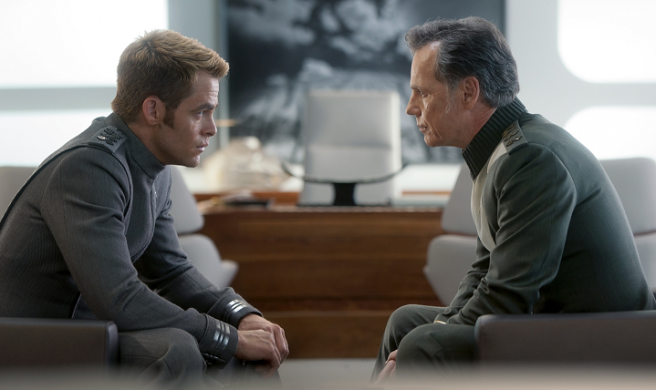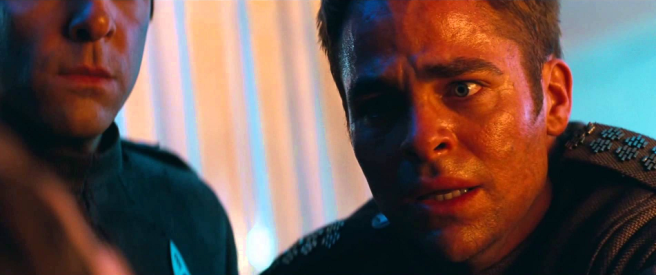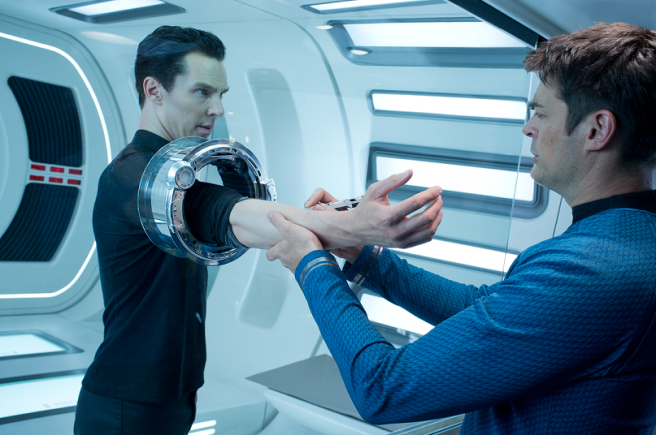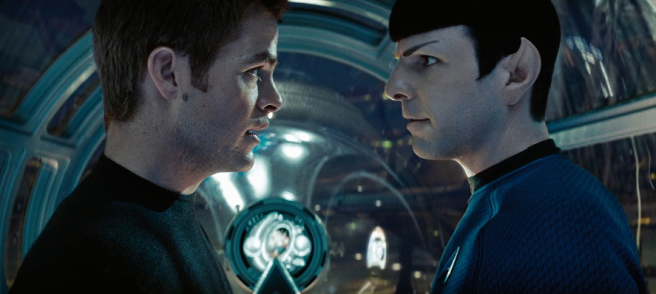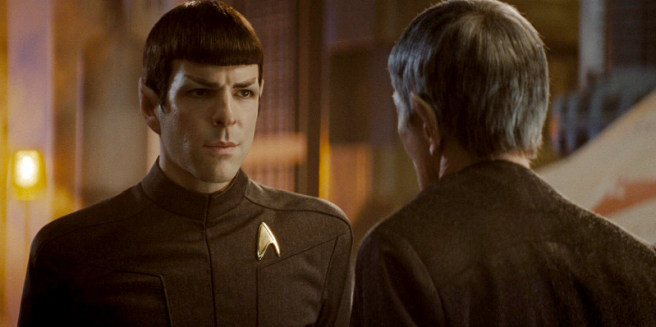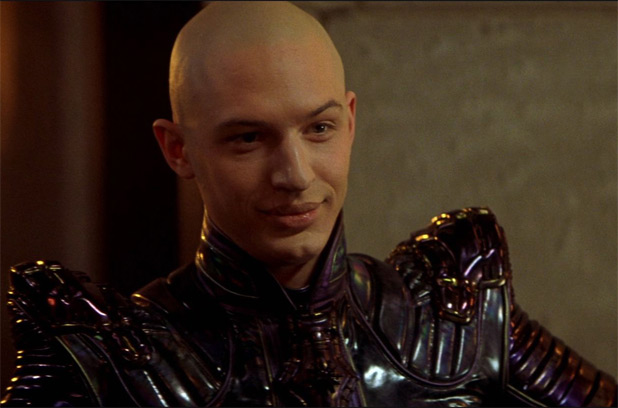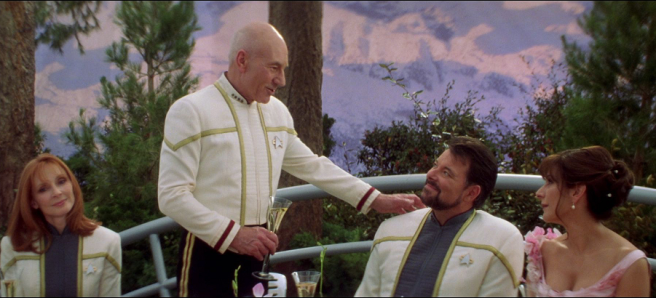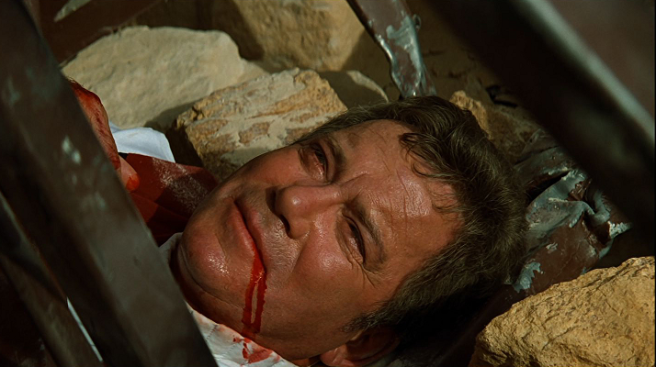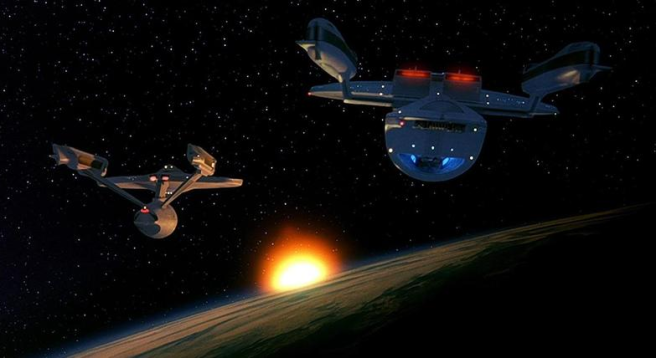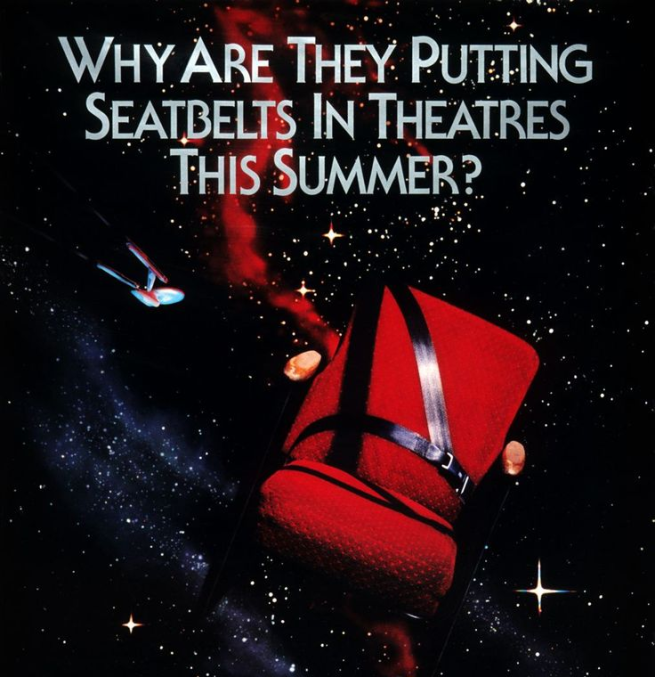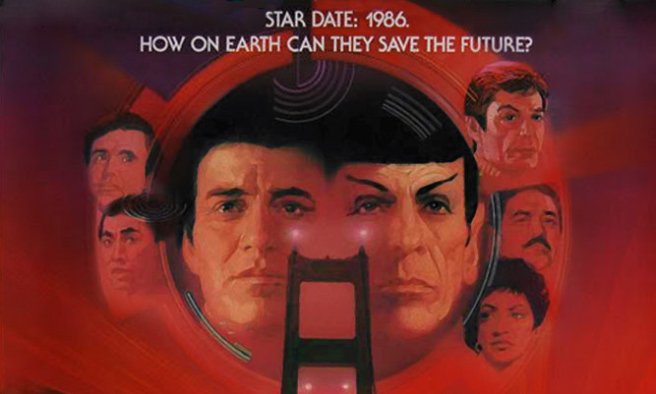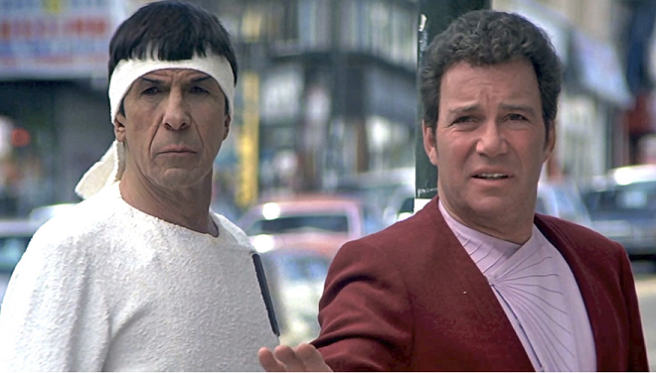
The Star Trek franchise is celebrating its 50th anniversary this year, and those who remember tuning into NBC on a cool September night in 1966 to see a hammy William Shatner and a Satanic-looking Leonard Nimoy battle a shapeshifting salt vampire through cardboard starship corridors couldn’t possibly have fathomed that we’d still be talking about this thing five decades later. As late as the Nemesis debacle and the failure of Enterprise, when Star Trek seemed to have attained its final frontier and been dismissed by the masses as terminally uncool, the property of sad neckbearded nerds in plastic pointed ears, we worried that we’d never have anything new from that universe again to keep us going – other than perpetual commercial-crammed reruns keeping us up late on lonely weekends, or old DVD’s dissected for some hitherto unknown piece of production trivia to make the whole thing seem fresh again. Trek was a box office loser, a past glory fated to fade away in a whimper rather than burn out.
And yet… here we are in 2016. Still boldly going.
Over the course of 37 years and now 13 films, Star Trek, like its audience, has evolved and adapted to changing eras, trends, and expectations. As leaps forward in visual effects technology have obliterated the limits of what moviemakers can realize with their imaginations, so too have the goalposts been shifting in terms of what the people sitting in the theater will crave. What stirred us as kids can jade us as adults; what once had us clinging to the edge of our seats will eventually yield only yawns. Our demands are nigh near impossible to accommodate: repeat the past note-for-note, we caution, and be labeled unoriginal; wander too far from the formula and be damned as a demographic-chasing heretic. Make it the same, but different, and better. Rising to the challenge, a football stadium’s worth of people have wandered through the Star Trek cinematic universe since 1979 attempting to put their stamp on it, appeal to the times and, perhaps in defiance of those first two objectives, stay forever true to the vision articulated by the late Gene Roddenberry of that hopeful, diverse future where the conflicts that make headlines today have been relegated to the realm of head-scratching ancient history. The success rate seems to hover at about 50/50; we’ve spoken about the odd-numbered Star Trek movie curse, we’ve seen triumphs when it hit all the right notes and embarrassments where it flailed vainly to speak to people who’d stopped listening to what it had to say. We’ve seen it make the most of limited resources and almost strangled by the ego battles associated with movie studio politics.
So on to this demanding stage steps Star Trek Beyond.

It’s strange to think that after only the second voyage of this rejuvenated and financially potent Enterprise crew that there might arise the need for a behind-the-scenes shakeup, but with J.J. Abrams lured from our galaxy to the pressing needs of another significantly more distant, Paramount was suddenly left without a captain for its flagship, even though Abrams would remain attached as producer (albeit with his workload likely reduced to mere infrequent consultation). Instead, Roberto Orci, who had co-written the two previous movies with Alex Kurtzman, took the lead on developing the script with writers J.D. Payne and Patrick McKay and lobbied the studio suits for the opportunity to helm his first feature. Wary of entrusting this important tentpole to a novice director, Paramount nonetheless extended Orci an offer to direct, contingent on their approval of the screenplay. The story ideas floated at the time however suggested a franchise unsure of where to head next: one intimated that the new movie would pick up where Star Trek Into Darkness had left off, with Starfleet going to war against the Klingons and Benedict Cumberbatch returning as Khan, and another said that there would be no villain at all and that the movie would try to recapture the original series’ spirit of exploration.
Whatever was in Orci’s pages, it wasn’t enough to seal the deal, nor was his cause aided by his online behavior: always an enthusiastic participant in social media and on Star Trek message boards, Orci had become bitter and foul-mouthed in his responses to fan criticism of Into Darkness (one exchange had him boasting “this is why I get to write the movies, and you don’t”), and he eventually deleted his Twitter account. Orci withdrew from the director’s chair in December of 2014 (remaining credited as producer, but effectively with no further involvement) and Justin Lin, veteran of the Fast & Furious series and TV’s True Detective, assumed his place a few weeks later, after a brief campaign by Jonathan Frakes to get the job went unanswered. The Orci/Payne/McKay script was binned and Lin was told he could come up with his own idea from scratch. For writing duties he enlisted the aid of Doug Jung, who had worked on the TV series Dark Blue and Big Love, and none other than Simon Pegg – continuing into this new generation the tradition of Star Trek‘s actors contributing behind the camera as well as in front of it.

In interviews accompanying the announcement of his involvement as writer, Pegg explained that the studio had found the Orci script bogged down in the obsessive minutiae of the Star Trek canon – “too Star Trek-y,” as he put it, with its potential appeal limited only to diehard fans. His and Jung’s new approach would be to first structure the movie like a heist film or western, and then populate it with the Star Trek characters, in the hopes of reaching the sort of audiences that would happily flock to see The Avengers three times without wanting to or having to understand the decades of often perplexing history that preceded it. Absent would be questions of politics spread across the light-years; this would be a good old-fashioned action-adventure story that didn’t ask you to remember how to retrofit a warp core, or to keep track of the motivations of dozens of different characters with funny names full of apostrophes.
With the main seven heroes under contract, only three major guest aliens were required: acclaimed British actor Idris Elba would be slathered unrecognizably in prosthetics as unstoppable villain Krall; rising star Sofia Boutella, who had played a baddie with blades for legs in Kingsman: The Secret Service would be painted in zebra stripes as the helpful, beats-and-shouts-loving Jaylah (taking her character’s name from Jennifer Lawrence’s celebrity moniker J. Law) and Lydia Wilson, from the magic realist rom-com About Time (featuring Pegg’s frequent co-star Bill Nighy) would take the role of Kalara, a mysterious captain whose distress signal sets the plot into motion. Persian-American actress Shohreh Aghdashloo was also added to the cast late into production as a Starfleet commodore. To save money, the majority of filming took place outside the U.S., a first for a Star Trek production, with soundstages in Vancouver, B.C. used as the primary location and additional scenes filmed on the futuristic streetscapes of Dubai.

The hiring of Justin Lin led more than a few fans to speculate yet again as to whether Star Trek was being lobotomized for the ever-crucial and expanding teenage demographic, and the first teaser trailer for Star Trek Beyond did not do much to dispel the notion, featuring Chris Pine’s Kirk leaping across bridges and chasms on a motorcycle as the Beastie Boys’ “Sabotage” blared. Simon Pegg sought immediately to calm the Trekkies’ collective frayed nerves, opining that he was not fond either of what had been cobbled together by marketing to highlight the action-intensive parts, and assuring us that the movie as a whole was more substantial than that. In fact, Pegg assumed the role of Beyond‘s primary defender when the movie waded into a most unexpected – if ultimately minor – controversy around the character of Mr. Sulu in the months before its release.
For a franchise that had prided itself on its long-standing embrace of diversity, Star Trek had steadfastly avoided the question of gender and sexuality, apart from one or two clumsy attempts in the early 90’s. Gene Roddenberry had frequently told convention audiences that he wanted to introduce gay characters, but those plans never came to fruition – a Next Generation AIDS allegory script that was to have featured a male/male pairing was scuttled before it could be shot, and the agender race in the episode “The Outcast” was cast entirely with female actors for fear that the love story between one of them and Riker would wig folks out. Deep Space Nine featured a f/f kiss, but it was wrapped in the trope of “forbidden passions” between a character who identified as straight in her other 100 appearances, and a one-shot guest star. Voyager, Enterprise and the twelve preceding films had steered entirely clear. For fifty years, Star Trek had never dared to breach the final frontier of establishing one of its heroes as gay, but it was 2016 now. Surely we had outgrown the last of our old prejudices?

In Star Trek Beyond, Pegg and Jung wanted to make a statement without making a statement; that is, portray the sexuality of an important main character (not a quickly forgotten redshirt) with the kind of casual indifference that would be shown if it were entirely heteronormative, as would be expected in the more evolved world of the 23rd Century – when interaction with multiple alien species would lead humans to embrace a much more pansexual and fluid gender view of themselves. In tribute to George Takei, who had become an icon and activist for the worldwide LGBT community since coming out eleven years earlier, the writers chose Sulu. Sulu was given a husband, Ben (played by Jung himself at John Cho’s suggestion) and a young daughter, Demora (as established by Star Trek Generations). Perhaps it was hoped that Takei would be moved by the portrayal, and indeed he was, but in the opposite direction. Takei took to the airwaves to claim that Roddenberry had never intended Sulu to be gay, that he was conceived as a straight man and should have remained such. Pegg wrote a rebuttal on his blog explaining their decision and providing an in-universe rationale as to how the Prime Sulu (eg. Takei’s version) could be heterosexual, preserving Roddenberry’s original intent, while Cho’s version wasn’t. But the debate would be laid aside when tragedy struck just before release: Anton Yelchin died suddenly at the age of 27 when his own vehicle ran over him in the driveway of his home. The question of Sulu’s sexuality became immediately less pressing as the cast and crew grieved for their friend under the spotlights of red carpet movie premieres.

(Author’s note: this would normally be where I would go into a detailed summary of the plot; given that Star Trek Beyond is still in theaters as I write this, I will demur in order to avoid specific spoilers, but before you tread further, please note that they may come up in the course of the actual review. Consider yourself duly warned.)
Beginning in 2009, the revitalized Star Trek had essentially owned the big screen science fiction market, cementing itself as the yardstick by which pretenders to the genre would be measured. This worked fine for a while as even the underwhelming Into Darkness manage to achieve massive box office success. But in December of 2015, the world was introduced to Rey, Finn, Poe and BB-8. Star Trek immediately became something of an afterthought, with reactions to its rollout akin to “are they still making those?” Fairly or not, Star Trek Beyond would fall under the shadow of Star Wars, and to a certain extent the surprise Marvel sci-fi smash Guardians of the Galaxy, which had come out two summers before (and featured Saldana as one of its leads). Would it stake new ground or let itself be influenced by its competitors? The answer is the latter, with the caveat that such influence doesn’t in this instance make for a lesser experience – so long as you go in with the right attitude.
Being a fan of the modern Star Trek cinematic universe is accepting that the days of plots hinging on characters engaging in heated moral debates over a briefing room table are long gone. The pulse of these new movies beats much quicker, and you can either choose to keep up or let them race ahead without you and seek solace in your copy of The Wrath of Khan instead. Star Trek Beyond is a trek for the age of Marvel and The Force Awakens, with a similar lightweight, straightforward plot about a group of rag-tag heroes who have to come together to stop a ruthless bad guy from using a superweapon to destroy their world – nothing more complicated than that. Of course, our heroes here aren’t a band of misfits, they’re a professional crew who have already been through two adventures together aboard a state-of-the-art starship, so Pegg and Jung’s script essentially pushes the reset button by destroying the beloved Enterprise and stranding the crew in separate pairings on an alien world before the movie has reached the thirty-minute mark.

Ironically those first thirty minutes are where Beyond reserves the majority of its sheer spectacle; a quality that the first four decades of Trek films lacked. Starbase Yorktown, where the Enterprise docks for resupply after being out in space for three years following the end of the previous film, is a jaw-dropping creation that Gene Roddenberry and his 1960’s designers could only have dreamed about (assisted by a few era-appropriate doses of acid). Described on-screen as an elaborate snowglobe in space, it’s a visual feast of skyscrapers and hundred-mile-long glass tunnels large enough to accommodate starships stretching out in every gravity-defying dimension, with infinite minute details that it would take at least a dozen viewings to absorb and sort out, and the only shame is that we don’t spend nearly enough time there before the plot kicks in and we set out into space again. Star Trek has too often underwhelmed in its visuals, and it is as if Justin Lin and his effects team are trying to make up for every missed opportunity of the past by cramming them all into one.
The planet on which the majority of the film’s action takes place, Altamid (taking its name from an anagram of Matilda, daughter of Simon Pegg) is likewise an effective exercise in the subtlety of worldbuilding: if Pandora from Avatar is filmed sci-fi’s gold standard and the endless boring trips to L.A.’s Bronson Canyon that characterized most of Star Trek‘s alien landscapes to this point are the definition of half-assing it, then Altamid scores a respectable silver. It is never weird enough that we spend all our time gaping at the scenery to the detriment of losing our focus on the characters, but there are lovely little added digital touches (in the form of unusual plants and tiny creatures scrabbling over the local rocks) to give us the sense of elsewhere and that this isn’t just a municipal forest tract five miles from the studio. It speaks to a most welcome level of care about the details, about recognizing that we as an audience want to be immersed in a place that we’ve never seen before. We want to explore strange new worlds just like the characters do, and we’re savvy enough to recognize an indoor set when we see one.

Pretty scenery isn’t worth a bucket of tribbles if you don’t populate it with interesting characters, however, and Star Trek Beyond succeeds not only in giving each of the ensemble something substantial to do (one cannot help but grin at Pegg’s significantly larger role this time around given he was the one co-writing it) and in introducing a compelling new member of the family (Boutella’s spry and upbeat Jaylah) but in finally making Chris Pine’s Captain Kirk seem for the first time like a real captain, seasoned and tempered by his time in the chair instead of the impulsive, somewhat out-of-his-depth maverick he was in the first two films. His uniform collar is higher, and he stands straighter. Certainly part of this evolution belongs to the actor: no longer the unknown under the pressure of his big break, Chris Pine has become a major movie star with plenty of significant roles under his belt, and he moves and speaks with an authority that he simply didn’t have before (and was most glaringly absent whenever he had to share the screen with Benedict Cumberbatch). When he gives an order, it’s with conviction and certitude, and you can’t imagine the crew still thinking of him as that smarmy punk who fell ass-backward into a captaincy. But as Beyond begins, this new commanding Captain Kirk is restless, wondering about a greater meaning to his life, and worrying that he is losing himself to the unknown that frames his every day of existence. It takes a kick in his complacency – the destruction of the comfortable confines of his ship and an encounter with a man who has lost himself to the unknown to lead Kirk to rediscover his purpose.

In my rather snarky review of Star Trek Nemesis I talked about the misguided choice to make that movie largely about its (lame) villain. Star Trek Beyond, by contrast, is a much better example in how to craft your bad guy from a personification of your hero’s flaws. The remorseless Krall comes on initially like a force of nature with his endless swarm of alien ships, wrecking the mighty Enterprise without much of a fight and stranding its crew on his world. We discover as the movie goes on that he is not as alien as we first thought, and that he was a human Starfleet captain named Balthazar Edison, a veteran soldier whose ship crashed on Altamid a hundred years ago with only three survivors. With no help forthcoming due to their remoteness and the inability of communications signals to escape the local nebula in which Altamid is located, Edison employed alien technology to prolong his life by draining others, which mutated him beyond recognition. He has literally lost his humanity, and as an old soldier put out to pasture with no one left to fight, he believes that the peace and unity among worlds promoted by the Federation will only make humanity weak (one suspects he and the war-hungry Admiral Alexander Marcus from Into Darkness would be kindred spirits). To that end he seeks to assemble an ancient life-consuming biogenic weapon (the “Abronath,” which sounds suspiciously like a small village in Scotland – likely writer Pegg being cheeky again) and unleash it on the diverse population of millions inhabiting the Yorktown in the hopes of renewing a galaxy-wide conflict.
This is Kirk’s listlessness and loss of purpose amplified with a healthy dose of rage, and in Edison/Krall, Kirk can recognize what he might become given similar circumstances and thus stake his own moral compass determinedly to the opposite direction. Although there is an element of revenge to Krall’s thinking, it’s not his sole motivation and it’s certainly refreshing given that we’ve had four villains in a row driven primarily by vengeance. There is a complexity to Krall that reflects more mature screenwriting, and the pity is that the Edison reveal takes place so late in the third act that we don’t really get the chance to chew over the duality of the basic conflict between himself and Kirk, the contrast between the two once-valiant starship captains. Also, the heavy makeup the role requires pretty much smothers the great Idris Elba, and he has a hard time emoting through the latex beyond the requisite evil growls and snarls. I wasn’t wild either about the “life force draining” aspect of his character, given that it (and the design of the corpses left in its wake) reminded me a little too much of that space vampire zombie movie from the 80’s…

Amidst imaginative visions of alien worlds and a villain determined to wipe it all out using an ancient gizmo that fits into the palm of one’s hand, Beyond manages to fit in a nice arc for Spock and McCoy too, giving their legendary combative friendship attention that has been absent with the first two films’ decision to focus primarily on the Kirk/Spock relationship. Spock in particular is much more like his old familiar self this time, less formative and more assured, with noticeable restraint shown in both the writing and the performance, and – thankfully – no rage eruptions in sight. There is a note of tragedy instead, with Spock grieving over the passing of Spock Prime, and doing so with dignity (only a single tear). It’s tough to gauge in fact where the performance ends and the genuine emotion begins. There are moments where the curtain drops and you are seeing Zachary Quinto grieving for Leonard Nimoy. In those scenes Karl Urban as McCoy becomes almost fatherly in his responses, as the character who is supposed to represent stoicism becomes the source of the movie’s deepest expression of heart.
Now, to the stuff that’s not so great. As a general rule, I haven’t been fond of the sillier scenes that have peppered the most recent Star Trek movies, and regrettably Beyond does cough up a few, including the climactic unleashing of the Beastie Boys as the ultimate weapon against Krall’s swarm ships, which has stretched my tolerance for their ongoing and increasingly grating presence in this universe to its breaking point (though to be fair, I did love McCoy’s subsequent joke about “classical music”). You just have to roll your eyes a bit and move on. One thing that is difficult to move on from, however, is the choice by the filmmakers to yet again destroy the Enterprise. The first time this happened, in Star Trek III, it was a true shock and an important beat in that film’s theme of sacrifice, and the reveal of the Enterprise-A at the end of Star Trek IV was a joyous surprise, a merited reward and a promise of greater things to come. When the Enterprise-D bit it in Generations, it was as part of a meaningless “wow sequence” designed to allow the series to continue with more modern sets and a sleeker, more cinematic ship (and to make matters worse, the characters didn’t seem that bothered by losing the home in which they’d spent the last seven years). Watching the Enterprise go down for the third time, early in the movie when we’ve barely gotten to know her and her destruction has been spoiled by the trailer, we don’t feel much of anything at all, apart from “there they go again.” Since we know the crew will get another ship in the end (as has happened twice before), the impact of this plot twist is muted, and it’s a tired gimmick that I hope we have seen the last of. However, it crystallizes my key issue with the movie, even as I land on the thumbs up side of the equation.

Fundamentally, Star Trek Beyond is not a journey forward, it is a stop on the side of the road to fix a tire. Everything about its story, from the conception of its villain to the construction of its plot, is about getting the characters back to exactly the same place they were in the beginning. This is not necessarily a bad idea; some of the greatest movies ever made are about finding your way home. But Beyond feels like a placeholder, or at best, a transition towards an even greater adventure (depending on the final grosses of course, which sadly have not been up to par with the previous two films). Like the Marvel movies, which manage to be simultaneously entertaining and forgettable, it doesn’t leave you with a lot to think about, except perhaps missed opportunities, and the expectation of something better – deeper, more provocative – the next time out. The movie does have a lot of good in it, especially in what seems like the most diverse cast of both leads and extras (and aliens) in any movie in recent memory, but it never manages to be greater than the sum of those good parts, perhaps because there is no greater aspiration inherent in its creation other than being a passable piece of fun summer entertainment. Which it most definitely is, with more heart in it than any other shoot-em-up you’ll see this season. Justin Lin’s direction, the source of controversy among fans the instant he was announced, isn’t as obnoxious as the trailers would lead you to believe, and while the pace is certainly in keeping with the action blockbusters that have made his reputation, he is astute enough to know to when to slow things down and give the characters (and the audience) a chance to breathe. And we do love these characters and this universe so much that we will doggedly follow their trek wherever it leads, or whomever is leading it.

As we’ve looked back at the peaks and valleys of Star Trek‘s cinematic history in the spread of these posts over the last couple of months, we’ve seen that what remains compelling even in its weakest outings is the vision at its core, the one that was first articulated by the flawed Gene Roddenberry, perhaps on some level out of the desire to remedy his own human failings, and shaped by the creativity of the people who came together around him. It is of a future where human ingenuity has lifted us out of our pettiest problems, where human ambition pursues not the meaningless acquisition of wealth but the betterment of the individual and the all, where fear of the other has been replaced by the unqualified celebration of our differences. The bells and whistles of special effects and chases across the stars are merely glittering ornaments on a sturdy and ever-thriving tree; that of a welcoming, wondrous galaxy that we want so desperately to touch, especially as our own world repeatedly lifts up leaders who seemed determined to prevent us from ever reaching it. After fifty years, there remains an unquenchable spark in the vision that is Star Trek. The hope, in the shadow of this most recent installment, is that next time, it truly does dare to go beyond.
Final (Arbitrary, Meaningless) Rating: 2 1/2 out of 4 stars.
All 13 Star Trek Movies, Ranked (again, arbitrarily):
- Star Trek II: The Wrath of Khan
- Star Trek IV: The Voyage Home
- Star Trek: First Contact
- Star Trek
- Star Trek VI: The Undiscovered Country
- Star Trek Beyond
- Star Trek: The Motion Picture
- Star Trek III: The Search for Spock
- Star Trek Into Darkness
- Star Trek: Insurrection
- Star Trek V: The Final Frontier
- Star Trek Generations
- Star Trek Nemesis


